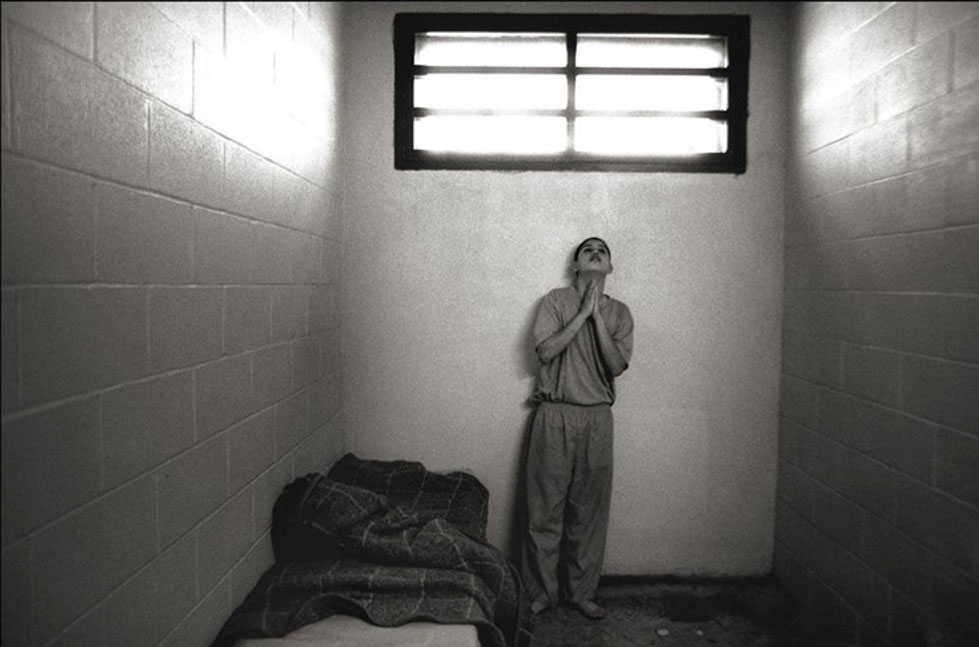
Photo: Pete Brooke
Our Editor, Vikram Zutshi, is making a feature documentary on the transformative effects of Yoga and Meditation in diverse communities. Every issue of Sutra Journal will profile a protagonist in the film. For the inaugural issue, he chose Anneke Lucas, whose heart-rending and uplifting story defies belief. Here is the conversation, without further ado.
Sutra Journal: what is the Liberation Prison yoga project? Can you tell us how it came about?
Anneke Lucas: Liberation Prison Yoga is a non-profit organization bringing trauma-informed yoga to incarcerated populations, and trains yoga instructors to serve inside prisons.
In 2010, James Fox, the founder of the Prison Yoga Project, asked me to find a space in New York so that he could train his yoga teachers. I did, and feeling responsible for the space, I ended up helping to organize the training. By the end, the participants looked to me for guidance as to what the next steps might be. By then I knew there was no organized effort in New York to help yoga teachers go into the prisons, so I began teaching incarcerated women at Bayview Correctional and men at Rikers, and brought in others who had trained with Fox. This became the Prison Yoga Project New York, which grew very quickly, serving six facilities. Running the programs became a full-time volunteer job, so I started Liberation Prison Yoga in 2014.
Sutra Journal: Where and when did you first encounter or discover Yoga? Can you tell us a little bit about your background, early experiences? How has Yoga changed something in you, or allowed you to see the world in a different way, perhaps?
Anneke Lucas: In 1993, living in Los Angeles, I read Autobiography of a Yogi and started attending meditations and services in temples that the author, Paramahanasa Yogananda, had built there.
As a child, I had experienced extreme abuse, and was trafficked in a murderous pedophile ring in Belgium. During those years I had often felt a loving presence that seemed to guide me.
I had often sat cross-legged with closed eyes, falling into spontaneous meditation without knowing what it was. Meditation came naturally to me, and from 1993 on, I learned the techniques that Yogananda came to teach in the West. Also in 1993, I took my first yoga class in Los Angeles.
In my late teens, before I left Belgium, I had taken stretching and strengthening classes in a dance studio, without being interested in dance. I liked the movements and continued to practice those exercises on my own after I moved out of the country. I had sustained severe injuries being tortured just before being rescued from the network at the age of eleven. I walked purposefully, to hide a limp from being stabbed in the back of my left knee. I was sworn to secrecy about anything regarding the network, and either way, I felt much too ashamed to ever speak up about how I received the injury, afflicted by a massive guilt complex in trying to make sense of the abuse.
At school, I had done all sports offered, and noticed that athletics helped me to walk without limping. When I began doing yoga, I realized the dancer’s exercises had been the closest I had found to yoga; it was as though I had been looking for a yoga practice my whole life. The yoga, especially ashtanga, was the miracle cure that enabled me to work through all the issues that arose from the past injuries, and maintain an extra healthy, youthful body.
Sutra Journal: What attracted you to working in prisons? What are your observations on the effects of Yoga after working many years with traumatized individuals and/or sex trafficking survivors?
Anneke Lucas: I didn’t mean to go teach yoga in prisons, but the moment I set foot inside, I felt right at home. I was once a prisoner too. I also have been treated as the lowest of the low. I have also been treated as though I were evil.
I went in expecting to find psychopaths, like the adults of my past, and instead found sweet, humble women and men who were open and full of grace. The connection I make with prisoners fills my heart with awe and gratitude. I went in to share love and have received back so much more than I can ever give. I found pieces of my own past inside the prisons, finally meeting others who have survived similar degrees of violence and personal devastation. I feel, for the first time in my life, really useful, knowing that the healing I’ve been privileged to enjoy brings hope to others struggling with the effects of abuse.
The yoga we bring inside the prisons is trauma-informed. The most important aspect of this is the human connection, so whatever the class is going to look like, we are there mostly to be present for our students. I’ve witnessed people coming out of deep isolation, able to share their pain in the group, followed by relief, upliftment, and support from the others.
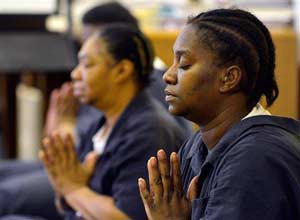
Photo: Richard Hamm/ Morris News Service - taken of mindfulness yoga class in Athens Clarke Co Jail, GA taught by Michelle Arington view news article
In jail, we don’t really work with people for long periods of time, but I have witnessed moments of incredible beauty. Sometimes we can just help to lighten someone’s load for a moment, and help them know that they can be heard and understood – that there is hope.
Students have reported that they felt they were changing because of the groups, that they were able to create space for their feelings, and as a result could muster the will to stop with drugs, which are of course available inside. I’ve heard powerful reports. In some instances I’ve been able to stay connected with students after they were released from jail, and am witness to their continued growth in their circumstances that embrace yoga as a living philosophy – not necessarily the physical practice.
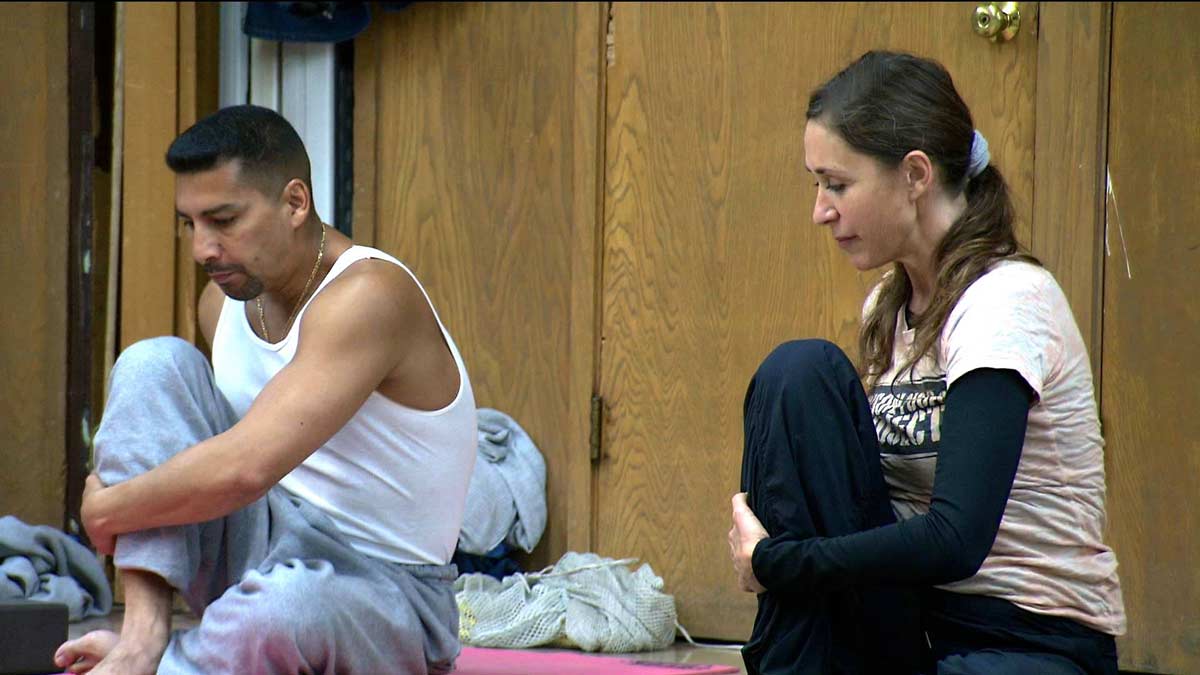
Photo: Taken at San Quentin - class taught by Anneke Lucas hosted by The Prison Yoga Project
Some of our students in prison, where our programs are more focused on trauma-informed hatha yoga, have found miraculous improvements in serious conditions, like the woman who had had a botched operation on her knee and walked with two canes when she first came to class.
She immediately felt that yoga was helping her, then started walking with one cane, then none, and she continues to come to class every week. More often we hear about mental benefits.
Students report they can accept themselves better now, and that they are better able to cope with prison life. Some students practice yoga every day in their cell.
Sutra Journal: What is your understanding of the word 'Yoga'? Do you delve into the deeper aspects of the Yoga Sutras or other spiritual texts? How has your personal practice evolved over the years?
Anneke Lucas: Yoga informs my life, and affects every single aspect. Paramahansa Yogananda has written extensive commentary on the Bhagavad Gita, and I am well aware that the field of Kurukshetra is before me every moment of my life, and that I have free will. I have studied the Yoga Sutras and the Sutras of the Saṃkya system, but I and the other teachers at Liberation Prison Yoga do not teach any philosophy unless we get specific questions – and that happens sometimes. What we do as teachers is make sure that we are mindful of the Yamas and Niyamas in our own lives and as we enter the prison.
We want to make sure we observe our own mental processes carefully, inside and out, so as to be fully present for the students. We do try to foster the idea of free choice through the asanas – that within each pose, each moment, there is a choice
We want to make sure we observe our own mental processes carefully, inside and out, so as to be fully present for the students. We do try to foster the idea of free choice through the asanas – that within each pose, each moment, there is a choice – i.e. how much or how little sensation to experience, and we stress that there are no wrong choices, no wrong thoughts.
We are not there to teach, but to share and to serve. We are not there to rehabilitate, but to help students discover that they are already perfect.
When I started meditation and yoga in 1993, the two were completely separate. I thought of the meditation as the real yoga, and the physical yoga as physical therapy. Bringing the yoga inside the prisons has finally helped me to combine the two, where the physical practice has its part within the much greater scope of the system.
In developing programs and teaching others, I learned to apply these techniques to help myself. Mindfulness especially, has really helped me to remain conscious of myself, and to introspect.
I have heard my own message of self-acceptance, and have been able to allow my anger to exist. I can observe my impulse to unleash it, and have worked to control that impulse with the very tools I teach. Service has helped me grow tremendously, and it remains the key to my happiness.
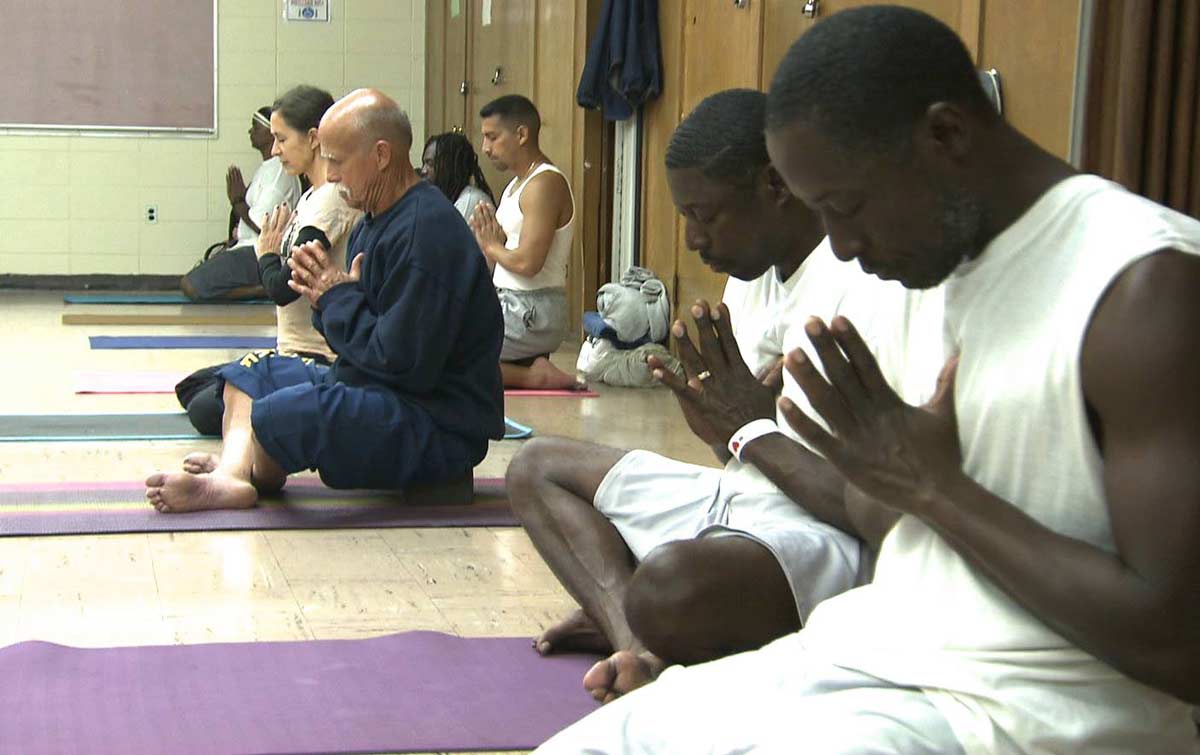
Photo: Taken at San Quentin - class taught by Anneke Lucas hosted by The Prison Yoga Project
Sutra Journal: Do you have any advice for people who may be going through an overwhelming personal crisis in their lives? How did you put the past behind you? How were you able to live positively?
Anneke Lucas: Overwhelming personal crises are tremendous opportunities for spiritual growth. Is there anything that matters more than the spiritual life, in the end? We want to be prepared for death – and I don’t mean that in a morbid way, but with the knowledge that life doesn’t end when we leave the physical body. All the great tests in life help us to know more deeply that we are not the body, and that the more we realize this, the stronger we are. If we were to trace every fear that we have down to its root, we’d find that it is some variation on the fear of death – of our own or our loved one’s bodies. The awareness that life is a school, and that the greater the lesson, the greater the resultant benefit – we need to be reminded of this when the struggle seems too great to bear.
We can’t judge anyone’s life from the outside. The Holocaust, for example, had many people believing that God cannot exist. But on a personal level, we have no idea what each person who died or lived through this experience went through. My childhood experience was of that magnitude, and I can honestly say that I would not want it do be different, because the insights I have received give me everything I needed for my particular spiritual journey.
I’m not saying that I would wish anyone else to go through to suffering I went through, including my abusers, but that we can only speak for ourselves.
Spiritual readings and expressions of the pain through poetry, journaling, or whatever creative means best suit the individual, and support from others through therapy or 12-step groups or other groups, are all helpful. There are so many resources available now. We do need to honor that the feelings, the grief, the anger, and so forth, all need room for safe expression, and that we don’t want to use the resources and helpful tools as buffers to prevent the feelings from being felt.
There is no spiritual bypass. It’s a process, and we can do whatever we need to do to remind us of its eventual benefit – even if that seems impossible in the moment. If we can embrace the challenge and truly heal, we will never have to go through that particular suffering again. That’s the karmic law.
This to me is why I feel I’ve met so many beautiful, graceful, spiritual guides in jail and prison – people who have fully embraced their journey, who have found gratitude and true humility in the most horrifying conditions – mostly unrecognized by the world.
Sutra Journal: What is it about yoga that makes it particularly suitable for trauma, depression, emotional crises, personal loss, and so on? Most of us go through a myriad of issues in our daily lives, some worse than others. How does this practice differ from a health and fitness routine?
Anneke Lucas: Yoga itself offers the broadest possible context for suffering, which is very helpful when you’re in the midst of it. The physical yoga practice has many recorded mental health benefits, as medical and academic studies have shown.
The only reason trauma-informed yoga is more helpful is because of its approach. It is the same, physical, yoga practice offered in a kind, respectful, accessible way, and maximized so that the participant can take advantage of all the benefits.
Sutra Journal: How do you feel about the commodification of yoga in the west and the narcissism that goes along with it? Is it being advertised and marketed in the wrong way, as a purely physical practice?
Anneke Lucas: One of the wonderful things that emerges from my work in developing these trauma-informed practices - adding other healing modalities, focusing on conscious self-awareness – is that it’s obvious that everyone stands to benefit from being taught yoga in this manner. There is no reason why yoga should be taught by barking commands at students like a drill sergeant. False gurus stand to benefit from controlling students to cover over their hidden purpose of greed and selfish aggrandizement, yet we all know that yoga is about self-empowerment, self-development, and that it is a personal journey.
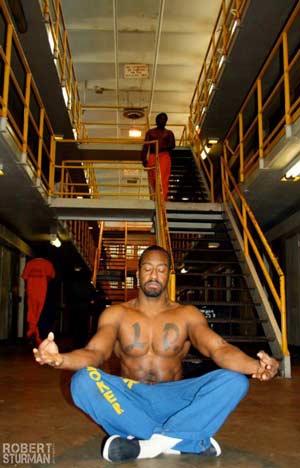
Yoga philosophy is often taught as dogma, and it may not be very accessible to students who have experienced the benefits of the physical practice and want to learn more. My teacher training sessions focus entirely on the teachers. We want to lead by example. We want to share what we have learned on our own journey of recovery in the context of spiritual growth, and not teach anything we can’t really know. Yoga teachers should not teach about Kaivalya or Samadhi – because only the truly enlightened beings could possibly give accurate accounts of these states, and we know these are extremely rare and probably too humble to be recognized by the masses. Yoga is experiential – that is why it is not dogmatic. And that is why it is potentially the greatest force to bring health and healing and peace to the planet.
Sutra Journal: Can you recommend some books that have made an impact on you and changed the way you see the world?
Anneke Lucas:
- Autobiography of a Yogi – Paramahansa Yogananda (SRF publication)
- The Holy Science – Swami Sri Yukteswar
- Mass Incarceration in the Age of Colorblindness - Michelle Alexander